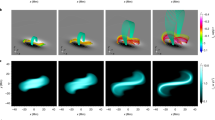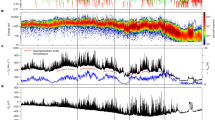Abstract
Coronal mass ejections (CMEs) are the most energetic events in the solar system and can make near-Earth space a hazardous place. However, there is still no consensus as to what physical mechanisms are responsible for these solar eruptions. Here we demonstrate a fundamental connection between the emergence of magnetic flux into the solar atmosphere and the formation of solar eruptions. We present a model of the dynamics of the solar atmosphere and inner solar wind region using a realistic representation of the electric field at the photosphere, calculated from flux-emergence computer simulations, as the boundary conditions. From this, we show how magnetic flux and helicity injection leads to the reorganization of the solar corona. We show evidence for the in situ formation of a CME plasmoid, which is independent of the emerging flux tube, and we conclusively connect this process to the formation of a hot X-ray structure.
This is a preview of subscription content, access via your institution
Access options
Subscribe to this journal
Receive 12 print issues and online access
$209.00 per year
only $17.42 per issue
Buy this article
- Purchase on Springer Link
- Instant access to full article PDF
Prices may be subject to local taxes which are calculated during checkout




Similar content being viewed by others
References
Gosling, J. T. Coronal mass ejections and magnetic flux ropes in interplanetary space. AGU Monogr. Ser. 58, 343–364 (1990).
Forbes, T. G. A review on the genesis of coronal mass ejections. J. Geophys. Res. 105, 23153–23166 (2000).
Low, B. C. Coronal mass ejections, magnetic flux ropes and solar magnetism. J. Geophys. Res. 106, 25141–25163 (2001).
Roussev, I. I. Eruptive events in the solar atmosphere: New insights from theory and 3-D numerical modeling. J. Contemp. Phys. 49, 237–254 (2008).
Amari, T., Luciani, J. F., Mikić, Z. & Linker, J. Three-dimensional solutions of magnetohydrodynamic equations for prominence magnetic support: Twisted magnetic flux rope. Astrophys. J. Lett. 518, L57–L60 (1999).
Amari, T., Luciani, J. F., Aly, J. J., Mikić, Z. & Linker, J. Coronal mass ejection: Initiation, magnetic helicity, and flux ropes. II. Turbulent diffusion-driven evolution. Astrophys. J. 595, 1231–1250 (2003).
Inhester, B., Birn, J. & Hesse, M. The evolution of line-tied coronal arcades including a converging footpoint motion. Sol. Phys. 138, 257–281 (1992).
Roussev, I. I. et al. A three-dimensional flux-rope model for coronal mass ejections based on a loss of equilibrium. Astrophys. J. Lett. 588, L45–L48 (2003).
Antiochos, S. K., Devore, C. R. & Klimchuk, J. A. A model for solar coronal mass ejections. Astrophys. J. 510, 485–493 (1999).
Jacobs, C., Roussev, I. I., Lugaz, N. & Poedts, S. The internal structure of coronal mass ejections: Are all regular magnetic clouds flux ropes? Astrophys. J. Lett. 695, L171–L174 (2009).
Roussev, I. I. et al. A numerical model of a coronal mass ejection: Shock development with implications for the acceleration of GeV protons. Astrophys. J. Lett. 605, L73–L76 (2004).
Roussev, I. I. et al. New Physical insight on the changes in magnetic topology during coronal mass ejections: Case studies for the 2002 April 21 and August 24 events. Astrophys. J. Lett. 668, L87–L90 (2007).
Leka, K. D. et al. Resolving the 180° ambiguity in solar vector magnetic field data: Evaluating the effects of noise, spatial resolution, and method assumptions. Sol. Phys. 260, 83–108 (2009).
Fisher, G. H., Welsch, B. T. & Abbett, W. P. Can we determine electric fields and Poynting fluxes from vector magnetograms and Doppler measurements? Sol. Phys. 277, 153–163 (2012).
Abbett, W. P. & Fisher, G. H. A coupled model for the emergence of active region magnetic flux into the solar corona. Astrophys. J. 582, 475–485 (2003).
Abbett, W. P., Fisher, G. H. & Fan, Y. The three-dimensional evolution of rising, twisted magnetic flux tubes in a gravitationally stratified model convection zone. Astrophys. J. 540, 548–562 (2000).
Fan, Y. The three-dimensional evolution of buoyant magnetic flux tubes in a model solar convective envelope. Astrophys. J. 676, 680–697 (2008).
Manchester, W., Gombosi, T., DeZeeuw, D. & Fan, Y. Eruption of a buoyantly emerging magnetic flux rope. Astrophys. J. 610, 588–596 (2004).
Manchester, W. Solar atmospheric dynamic coupling due to shear motions driven by the Lorentz force. Astrophys. J. 666, 532–540 (2007).
Archontis, V., Moreno-Insertis, F., Galsgaard, K., Hood, A. & O’Shea, E. Emergence of magnetic flux from the convection zone into the corona. Astron. Astrophys. 426, 1047–1063 (2004).
Archontis, V., Hood, A. W., Savcheva, A., Golub, L. & DeLuca, E. On the structure and evolution of complexity in sigmoids: A flux emergence model. Astrophys. J. 691, 1276–1291 (2009).
Linker, J. A., Lionello, R., Mikić, Z. & Amari, T. Magnetohydrodynamic modeling of prominence formation within a helmet streamer. J. Geophys. Res. 106, 25165–25176 (2001).
Linker, J. A., Mikić, Z., Lionello, R., Riley, P. & Amari, T. Flux cancellation and coronal mass ejections. Phys. Plasm. 10, 1971–1978 (2003).
Amari, T., Luciani, J. F., Aly, J. J., Mikić, Z. & Linker, J. Coronal mass ejection: Initiation, magnetic helicity, and flux ropes. I. Boundary motion-driven evolution. Astrophys. J. 585, 1073–1086 (2003).
Jacobs, C. & Poedts, S. A numerical study of the response of coronal magnetic field to flux emergence. Sol. Phys. http://dx.doi.org/10.1007/s11207-012-9941-8 (2012).
Fan, Y. & Gibson, S. E. The emergence of a twisted magnetic flux tube into a preexisting coronal arcade. Astrophys. J. 589, L105–L108 (2003).
Fan, Y. & Gibson, S. E. Numerical simulations of three-dimensional coronal magnetic fields resulting from the emergence of twisted magnetic flux tubes. Astrophys. J. 609, 1123–1133 (2004).
Amari, T., Luciani, J. F. & Aly, J. J. Coronal magnetohydrodynamic evolution driven by subphotospheric conditions. Astrophys. J. 615, L165–L168 (2004).
Amari, T., Luciani, J. F. & Aly, J. J. Coronal closure of sub-photospheric MHD convection for the quiet Sun. Astrophys. J. 681, L45–L45 (2008).
Roussev, I. I. et al. A three-dimensional model of the solar wind incorporating solar magnetogram observations. Astrophys. J. Lett. 595, L57–L61 (2003).
Tóth, G. et al. Space weather modeling framework: A new tool for the space science community. J. Geophys. Res. 110, A12226 (2005).
Tóth, G. et al. Adaptive numerical algorithms in space weather modeling. J. Comput. Phys. 231, 870–903 (2012).
Powell, K. G., Roe, P. L., Linde, T. J., Gombosi, T. I. & DeZeeuw, D. L. A solution-adaptive upwind scheme for ideal magnetohydrodynamics. J. Comp. Phys. 154, 284–309 (1999).
Priest, E. R. & Titov, V. S. Magnetic reconnection at three-dimensional null points. Phil. Trans. Math., Phys. Eng. Sci. 354, 2951–2992 (1996).
Titov, V. et al. Slip-squashing factors as a measure of three-dimensional magnetic reconnection. Astrophys. J. 693, 1029–1044 (2009).
Démoulin, P. & Aulanier, G. Criteria for flux rope eruption: Non-equilibrium versus torus instability. Astrophys. J. 718, 1388–1399 (2010).
Amari, T. & Aly, J. J. Magnetic flux ropes: Fundamental structures for eruptive phenomena. IAU Symp. 257, 211–222 (2009).
McKenzie, D. E. & Canfield, R. C. Hinode XRT observations of a long-lasting coronal sigmoid. Astron. Astrophys. 481, L65–L68 (2008).
Gibson, S. E. & Fan, Y. Coronal prominence structure and dynamics: A magnetic flux rope interpretation. J. Geophys. Res. 111, A12103 (2006).
Odstrcil, D. Modeling 3-D solar wind structure. Adv. Space Res. 32, 497–506 (2003).
Golub, L. et al. The X-ray telescope (XRT) for the Hinode mission. Sol. Phys. 243, 63–86 (2007).
Acknowledgements
This research work was supported by CAS grant 2011T2J01 at the YNAO, as well as NSF grant ATM-0639335 (CAREER) at the IfA. We are grateful to P. Biermann, M. Mierla and G. Dima for the useful comments on the manuscript. K.G. acknowledges the access to the Danish Center for Scientific Computing (DCSC) at which the FEM calculations were conducted. N.L. was supported by NSF grant AGS-1239704.
Author information
Authors and Affiliations
Contributions
I.I.R. and K.G. planned and performed the numerical simulations using the GSCM and FEM, respectively. I.I.R. and K.G. developed the coupled GSCM–FEM. I.I.R., C.D., N.L. and I.V.S. jointly developed the GSCM. I.V.S. participated in the development of the SWMF. The analysis of the simulation results and their interpretation was done by I.I.R., K.G., C.D., N.L., J.L. and E.M. Figures 1 and 3 were prepared by I.I.R., K.G. and E.M. Figure 2 was generated by J.L., I.I.R. and K.G. Figure 4 was prepared by I.I.R. and C.D. Supplementary Fig. S1 was prepared by I.I.R. The manuscript was written by I.I.R. with feedback from all authors, including significant contributions from K.G., C.D. and N.L.
Corresponding author
Ethics declarations
Competing interests
The authors declare no competing financial interests.
Supplementary information
Supplementary Information
Supplementary Information (PDF 404 kb)
Rights and permissions
About this article
Cite this article
Roussev, I., Galsgaard, K., Downs, C. et al. Explaining fast ejections of plasma and exotic X-ray emission from the solar corona. Nature Phys 8, 845–849 (2012). https://doi.org/10.1038/nphys2427
Received:
Accepted:
Published:
Issue Date:
DOI: https://doi.org/10.1038/nphys2427
This article is cited by
-
Fitting and Reconstruction of Thirteen Simple Coronal Mass Ejections
Solar Physics (2018)
-
The Origin, Early Evolution and Predictability of Solar Eruptions
Space Science Reviews (2018)
-
Buildup of a highly twisted magnetic flux rope during a solar eruption
Nature Communications (2017)
-
Origin and structures of solar eruptions II: Magnetic modeling
Science China Earth Sciences (2017)
-
Data-driven magnetohydrodynamic modelling of a flux-emerging active region leading to solar eruption
Nature Communications (2016)



